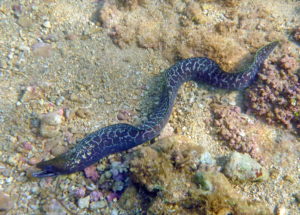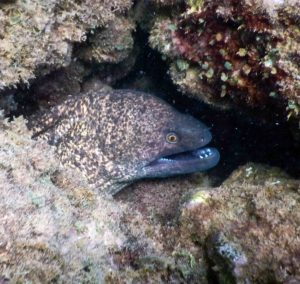September 18, 2020

This undulated moray, AKA puhi lau milo, (the leaf of the milo tree), has a row of sharp teeth down the center of its mouth, as do several other species. You can see the front center fang. ©Susan Scott
Years ago, while learning to windsurf at Waialae Beach Park, I came ashore to find a fellow windsurfer sitting on the grass examining his bleeding big toe. “What happened?” I asked.
“I stepped in the mouth of a moray,” he said. “My mistake.” And then he stood up and began breaking down his rig.
The wound was no big deal to that local surfer, but it left a big impression on me. For years, I feared stepping on, or getting a hand near, a moray eel. That fear heightened when I learned that Hawaii has an unusual abundance of inshore morays, 42 species.

Steindachner’s moray is common in the Northwest Hawaiian Islands, but ranges only as far south as Oahu, where it’s fairly rare. I’m lucky to see this one often in my North Shore snorkeling area. ©Susan Scott
Globally, about 200 moray eel species inhabit coral reefs and rocky ledges. The Atlantic Ocean gets only 50 of those. The other 150 live in the Pacific and Indian Oceans, and most of those species span the entire widths of those oceans’ tropical and subtropical waters, ranging from shallow intertidal depths to 650 feet deep.

This large yellowmargin moray, or puhi paka, peeked at me from its hole, thinking it was hidden. Surprise. The photo on the right is to the other side of the rock. The tail shows where this eel got its common English name. ©Susan Scott
Hawaii’s 42 species means we hosts nearly a quarter of all the moray eels in the world, a fact that doesn’t surprise us snorkelers and divers because we see them often. But why do our remote islands have so many of these fish that don’t swim particularly well, and tend to stick to territories a few yards square?

I often see moray eels swimming out in the open in the early morning, likely still out from a night of hunting. I rarely see them this exposed at midday. ©Susan Scott
Researchers offer several theories. One is that after their unusually large eggs (1-4 mm, with 1 mm being the smallest we can see with the naked eye) hatch, they turn into flat, transparent larvae that swim like, well, eels. Called a leptocephalus (“slender head”), this stage of development looks like a ghost eel. Check out this short video of a snake eel leptocephalus in deep water off Kona, bit.ly/2HbPaGz (bear with the intro. It’s worth it.)
Eel larvae are among the simplest, and most long-lived, of fish larvae. Except for eyes, the transparent body walls are only a few cells thick, and the inside contains no digestive system and no means of storing fat, carbs, or protein.
That means the youngsters have to eat constantly to stay alive, and they do, sucking in dissolved organic matter from dead plants and animals, as well as the waste products of live animal plankton. Such organic material, abundant in the open ocean, allows eel larvae to survive up to two-years, an advantage for long distance travel. A second, longer eel larva video bit.ly/2FwhT8F is so amazing I’ve watched it several times.
Another theory of why we have so many morays, is that Hawaii’s reefs lack the carnivorous competitors — groupers, snappers, and emperor fish — that compete with morays for food. Members of those fish families are common on coral reefs in other parts of the world, but not here, leaving more fish food for eels.

The DNA of the undulated moray was one of two Hawaii species studied for their geographical distribution. ©Susan Scott
A third theory explaining Hawaii’s multitude of morays is that being in the center of the ocean makes the island chain a kind of crossroads between the eastern Pacific and the western Pacific and Indian Oceans. Two of Hawaii’s studied species, the undulated moray (above) and the yellowmargin moray (below), have the same genetic makeup as those species in the Indian Ocean and the eastern Pacific.

The undulated moray was another Hawaii species studied using DNA to determine its distribution. ©Susan Scott
Moray eels can be fearsome-looking things, but all that neck pumping and baring of teeth aren’t signs of aggression. That’s just the moray breathing. Usually. It’s unwise to tease, touch, or feed, a moray eel. Those teeth can do serious damage to skin, tissue, and tendons.

Just breathing here, thanks. No offense. A whitemouth moray, puhi onio. ©Susan Scott
I see at least one moray eel, and often several, nearly every time I go snorkeling. The fact that I’ve never been bitten is a miracle, given my continual poking of hands and face into the reef’s nooks and crannies. But if a moray decides to inform me with its teeth that I got too close for comfort, I hope I will be as calm as the windsurfer with the bloody toe. But it’s not likely.

So intent was I on photographing this marbled shrimp, I never saw this puhi paka watching from below. Lucky I still have my nose. ©Susan Scott